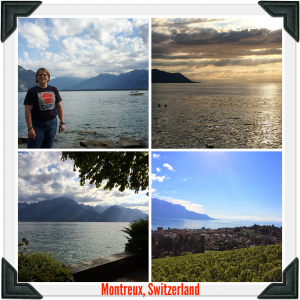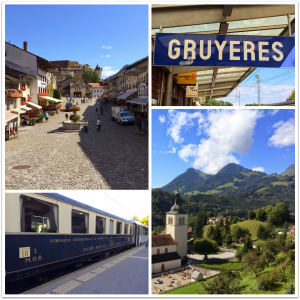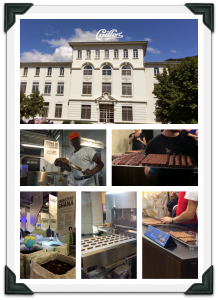Montreux, Gruyères, and the History of Swiss Chocolate
 Greetings from Switzerland! I am once again the beneficiary of Tim's need to travel for business.
Greetings from Switzerland! I am once again the beneficiary of Tim's need to travel for business.
On Thursday August 21, 2014, we arrived in Zürich. We purchased a 4-day Swiss Pass at the train station and enjoyed a 2.5-3 hour journey to Montreux.
The Swiss Pass provided us with unlimited access to the Swiss rail system and to most Swiss museums.
Montreux
Montreux is a beautiful town on the shores of Lake Geneva. It may be the most beautiful place we have visited thus far and we are fortunate to have traveled a lot.
The water in the lake shifts from bright to dark blue. Depending on the time of day, you can see the local Alps and clouds reflected in its surface. Nearly all of the water in the lake comes from mountain snow melt.
After we checked into our hotel, Tim and I walked the pedestrian path around part of the Lake. The Montreux waterfront reminded us of a boardwalk-like area with restaurants, shops, and people on foot, bikes, and rollerblades along its paved paths. Statues of Charlie Chaplin and Freddie Mercury stand along the waterfront as both established homes in this scenic and relaxing town.
Chocolate Train
We visited Montreux so we could take the “Chocolate Train” into Gruyères, which we did on Friday August 22, 2014. The train featured antique rail cars pulled by a modern, electric engine. The train ride to Gruyères took about an hour, but that hour was filled with scenic vistas of the Alps, Lake Geneva, and the towns and valleys in between.
At Gruyères we disembarked our train and went inside La Maison du Gruyères, a cheese factory. The factory makes up to 12, 35 kg cheese wheels at one time. La Maison du Gruyères provides a multi-lingual audio tour that discusses the uniqueness of Gruyères cheese and how it is made. Windows above the manufacturing operations allow visitors to view the cheese makers at work.
 In the United States we have a penchant for calling Swiss-made cheese “Swiss.” However, there are many different kinds of Swiss-made cheese. Gruyères is a distinct cheese because the cows graze along the slopes of the Alps and ingest many different kinds of flowers, herbs, and grasses. The scents and flavors of the flowers, herbs, and grasses pass into the cow’s milk, which provides cheese from Gruyères with a distinct taste and smell. The audio guide stated that scientists have identified at least 75 different scents and flavors in slices of Gruyères cheese.
In the United States we have a penchant for calling Swiss-made cheese “Swiss.” However, there are many different kinds of Swiss-made cheese. Gruyères is a distinct cheese because the cows graze along the slopes of the Alps and ingest many different kinds of flowers, herbs, and grasses. The scents and flavors of the flowers, herbs, and grasses pass into the cow’s milk, which provides cheese from Gruyères with a distinct taste and smell. The audio guide stated that scientists have identified at least 75 different scents and flavors in slices of Gruyères cheese.
Gruyères
After 45-60 minutes at La Maison du Gruyères, we boarded a bus for the town of Gruyères.
Gruyères received its name from the grue or cranes that flew in the area and inspired the initial lord to settle the lands. The noble family adopted the grue as its family sigil and today the sigil continues to fly above the town and region on local flags.
The town of Gruyères contains a medieval town and castle, which dates to 13th century.
We enjoyed about 2 hours in Gruyères. We toured the castle and explored its medieval town. We stopped for lunch at the site of the old grain house where we enjoyed our first traditional Swiss meal: raclette. Our raclette included potatoes, bread, gherkins, and onions over which we scrapped melted layers of Gruyères cheese. It was delicious.
Since no vacation meal would be complete without dessert, we splurged on a traditional regional dish: fresh strawberries with double cream. The cream of the Gruyères region is very thick and heavy. It is sweet and its consistency reminded me of greek yogurt.
 Cailler and an Interactive History of Swiss Chocolate
Cailler and an Interactive History of Swiss Chocolate
Following lunch, we boarded a bus to the Cailler chocolate factory in nearby Broc.
Cailler is the oldest chocolate brand in Switzerland. During the Great Depression the firm merged with Nestlè.
The Cailler factory tour proved to be an interesting experience with historical interpretation. The experience seemed to be part Walt Disney World attraction and part sales pitch.
Our tour began by entering an elevator. The elevator descended one floor below and opened into a re-creation of a mesoamerican jungle. A voice overhead informed us that the Aztecs of Mexico were the first people to eat and drink chocolate. The narrator told us the Aztec origination story of chocolate and how they received it from Quetzalcoatl, the god of wisdom.
The Aztecs used cocoa beans as currency and to make a warm chocolate drink, which they consumed before battle or sex. Only Aztec men consumed chocolate as its heat and effects were considered too much for women.
The Aztecs introduced chocolate to Spanish Conquistador Hernan Cortés.
After the program introduced Cortés, a door opened to another room. The room we entered looked like a ship. The narrator explained that along with gold, Cortés had filled the hold of his ship with chocolate. Cortés introduced cocoa beans and the spicy, bitter Aztec chocolate drink to Spain. The Spanish decided that they really liked the drink after they added sugar to it.
Chocolate spread throughout Europe during the sixteenth century. However, its consumption caused controversy as some Catholic groups feared that its consumption constituted a sinful act. These groups argued the chocolate came from heathens (the Aztecs) and broke fasting rules. Pope Pius V ended the controversy in 1569 with a declaration that Catholics could consume chocolate drinks without fear of sin or of breaking their fasts.
After the papal blessing of chocolate, another door opened and we entered 18th-century France.
Anna of Austria grew up in Madrid and brought her love of chocolate to the French Court in 1615. The French loved chocolate and developed additional ways to make it sweeter. However, chocolate was expensive and a pound of it would have cost your typical French laborer about a year’s salary.
The French nobility loved their chocolate. Like the Aztecs, they believed it to be an aphrodisiac and often consumed it before sex. Chocolate consumption among the non-nobility did not increase until after the French Revolution. By 1830 the French had developed ways to make chocolate more palatable in solid forms
The Swiss became involved with chocolate in 1819 when François-Louis Cailler opened one of the first mechanized chocolate factories in Corsier, Switzerland. His original chocolate recipes are still made today by the Cailler plant in Broc. World appreciation for Swiss chocolate grew as tourism to Switzerland increased between 1890 and 1920.
The rest of the tour discussed the history of Cailler and its merger with Nestlè during the 1920s. The interactive history lesson ended with a trip through Cailler advertising history. Several TV screens flashed old commercials and chocolate bar wrappers at the audience.
After the history lesson, the tour let out into a room that contained different types of nuts and cocao beans in large boxes that you could smell and touch. From these boxes we wound our way through the corridors where we viewed how Cailler makes some of their chocolate products. The tour ended with a tasting room reminiscent of all your Willy Wonka fantasies: Unlimited tasting of different Cailler chocolates.
Return to Montreux
Once we had filled our bellies with chocolate, we walked back to our train, which met us at a nearby train station. Our ride home proved just as scenic as our ride to Gruyères. However, as we rode back to Montreux, I couldn’t help but appreciate the grasses, flowers, and grazing cows I saw along the Alpine slopes. These natural wonders are not only beautiful, but they help make the cheese and chocolate we enjoy.
 Share Your Story
Share Your Story
What is the most scenic place you have ever seen?
What is your favorite type of cheese and/or chocolate?
